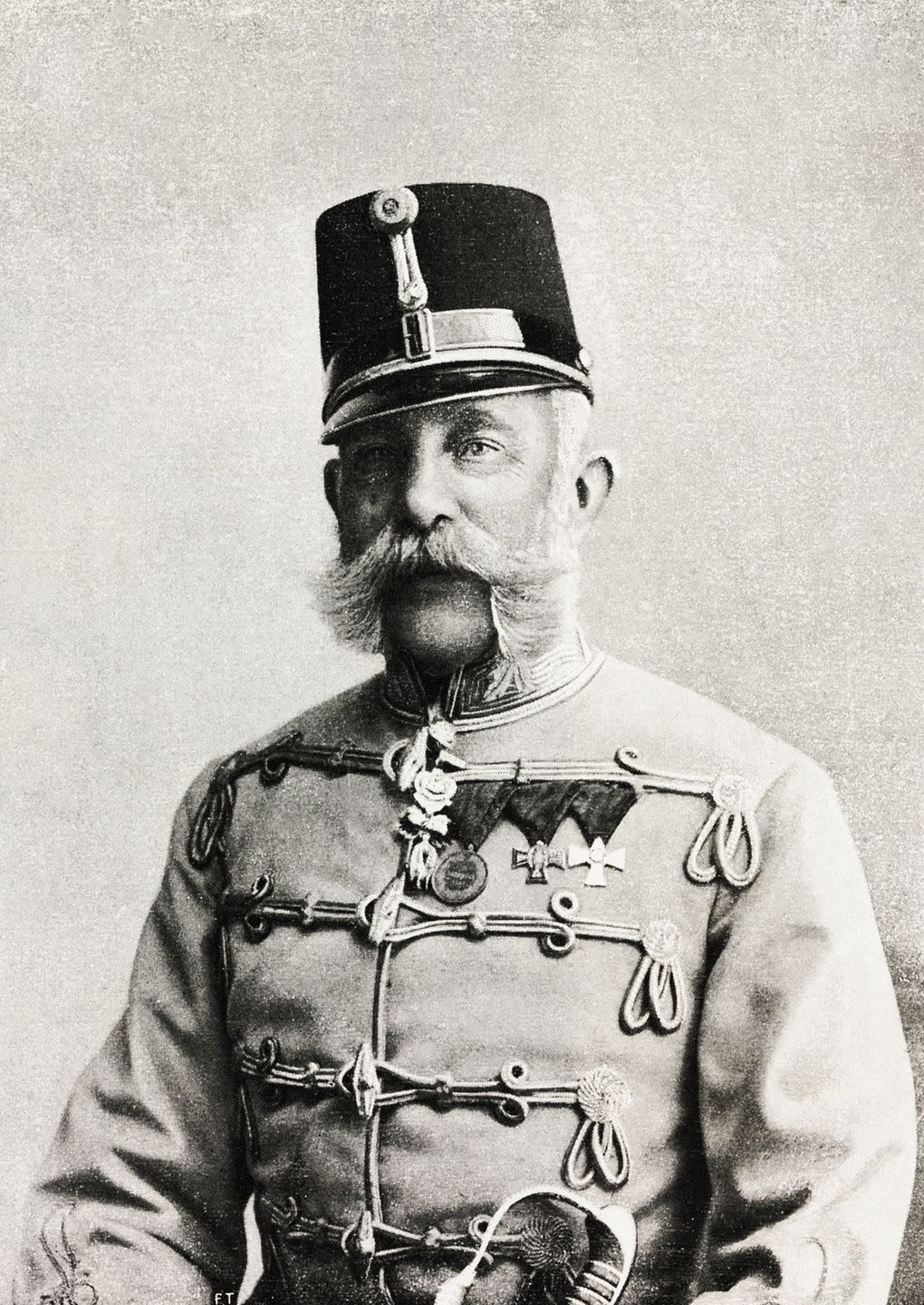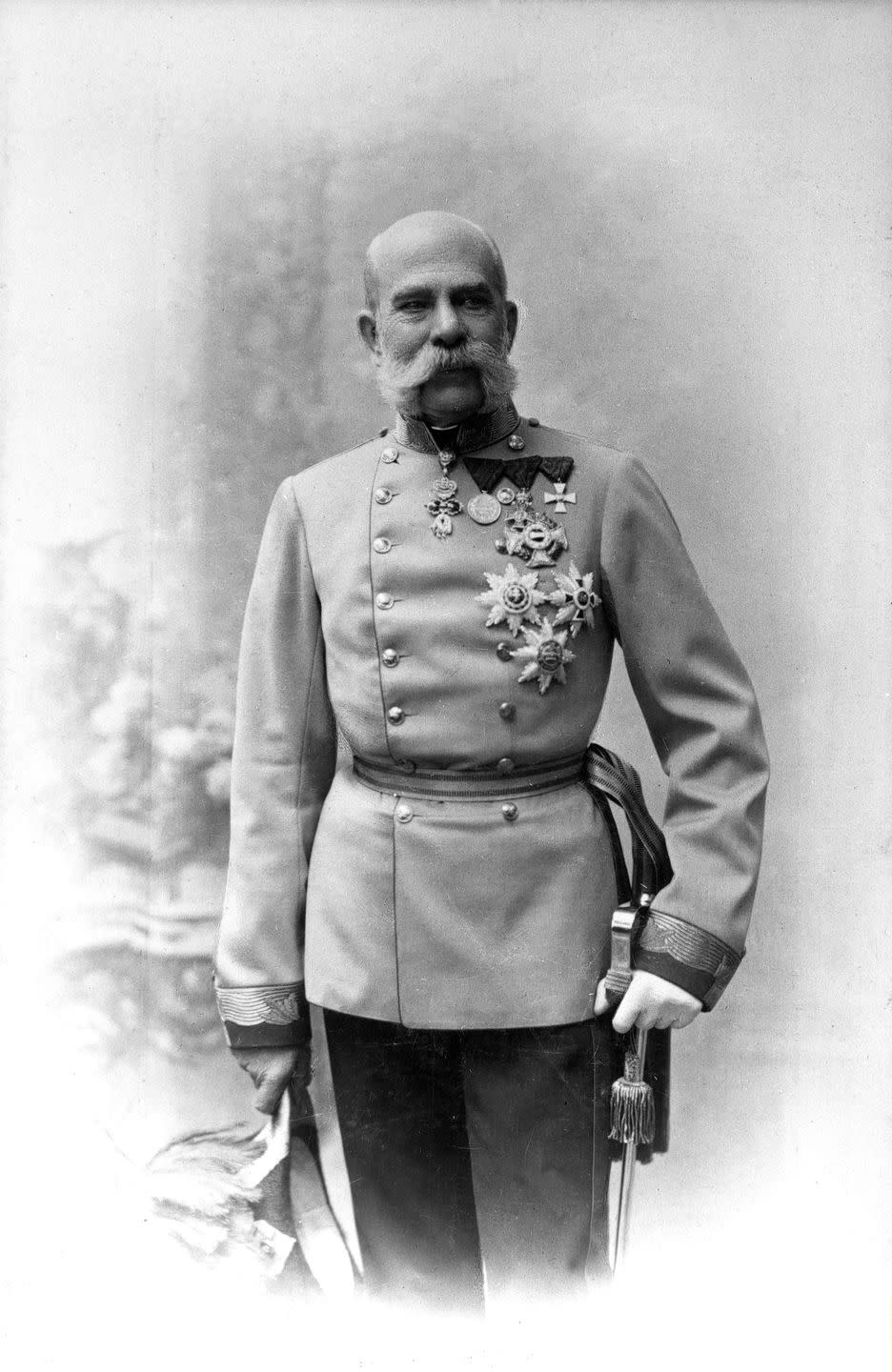'The Empress's IRL Courtship Was Just As Dramatic As The TV Show

The Empress hit Netflix last week, and it's already become the new obsession to satisfy Bridgerton and The Crown fans' thirst for an epic historical drama. The German show is based on a true story about a young woman who marries into the Viennese court when she falls in love with Emperor Franz Joseph I.
The series focuses on Elisabeth von Wittelsbach, the Empress of Austria from 1854 to 1898, and chronicles the challenges she faced while struggling to adapt to royal life, per The Cinemaholic.
But these stories are more than just beautiful sets, intricate costumes, and intriguing characters—these are the tales of real people in the world's history.
Here's everything you need to know about Elisabeth of Austria's husband, Franz Joseph I.
Who was Franz Joseph I?
Franz, sometimes also called Francis, Joseph I was born on August 18, 1830, according to Brittanica. He was the oldest child of Archduke Francis Charles and Sophia, daughter of King Maximilian I of Bavaria. Franz's uncle, Emperor Ferdinand (I) was childless, so he was treated as his heir.
He officially took over as the Emperor of Austria on December 2, 1848, per Britannica. Franz was 18 years old at the time.

He was married to Elisabeth of Austria.
Franz married Elisabeth von Wittelsbach, commonly known as "Sissi" or "Sisi," per Tatler. They married when she was just 16 and he was 23 years old.
Despite original attempts to convince Franz to marry her older sister, Helene, he fell in love with Sisi after they met at a party celebrating his 23rd birthday, per The World of Habsburg. Their engagement was announced soon after they met, and they wed in Austria in 1854.
Elisabeth then became the Empress of Austria. She and Franz had four children together.
He was the longest ruler of the Austro-Hungarian Empire.
Franz was the emperor of Austria from 1848-1916 and the king of Hungary from 1867-1916, according to Brittanica. His two roles divided his empire into the Dual Monarchy where Austria and Hungary coexisted as partners.
Franz Joseph I ruled for 68 years before he died in 1916, per City of Vienna.
Franz was crowned King of Hungary in 1867.
After Austria was defeated by Italy in 1859 and Prussia in 1866, Franz faced some backlash and his position within the Monarchy weakened. To combat these losses, Franz made a compromise with the representatives of Hungary, and in 1896, he agreed to the Compromise Plan, per The World Of Habsburgs. The plan restored Hungary's independence and reinstated the old Hungarian constitution.

Though Franz ruled over both Hungary and Austria at one time, the two were independent states with equal status.
His brother Maximilian I of Mexico was executed in 1867.
Franz's younger brother, Archduke Ferdinand Maximilian Joseph of Austria, took over the Mexican crown in 1863, per Britannica.
His rulership was a rocky time in Mexico with many brutal struggles leading up to his execution. Maximilian was killed near Querétaro, Mexico, in 1867, Britannica reported.
The relationship between Franz and Maximilian is demonstrated in the new Netflix series. Despite Maximilian's close friendship with Elisabeth, he did not have the same strong bond with his brother, Franz, according to Digital Mafia Talkies.
In fact, he was not a supporter of the emperor and felt that his brother did not trust him enough to give him a significant role in the empire.
There were also speculations about Maximilian's romantic feelings for Elisabeth which play out in the new show, per Digital Mafia Talkies.
Franz's nephew and heir was Franz Ferdinand.
Franz Joseph and Elisabeth's only son, Rudolph, died in 1889, per The Palaces of Europe.
As a result, Franz's nephew, Franz Ferdinand, became the next heir to the throne, per The World of Habsburgs.
The two Franzs did not get along. They had conflicting political views that impacted their relationship. Franz Ferdinand wanted to modernize the Court and developed ambitious plans for the monarchy's future that Franz Joseph rejected.
Franz Ferdinand was also an opponent of the Hungarian Compromise and wanted instead to focus on a deeper involvement in the Slav nationalities, according to The World of Habsburgs.
The assassination of Franz Ferdinand sparked World War I.
Franz Ferdinand agreed to attend a series of June 1914 military exercises in Bosnia-Herzegovina as Franz Joseph's inspector army general, according to History.
However, when the Young Bosnians, a secret revolutionary society of peasant students, heard about Ferdinand's visit, they began a plot to assassinate him.
While driving in a car, Ferdinand and his wife were both shot and killed by a man named Gavrilo Princip, per History.
Tensions were already at a high point among Europe's powers, so the assassination added to the upset and spiraled into World War I. Austria-Hungary gained support from Germany to send an ultimatum to Serbia. Despite Serbia's attempt to resolve the dispute, Austria-Hungary declared war on July 28, 1914, exactly a month after Ferdinand’s death, History reported.
By the next week, Germany, Russia, France, Belgium, Montenegro, and Great Britain had all joined in the conflict. Other countries, such as the United States, entered later.
More than 9 million soldiers and almost as many civilians died in World War I, per History.
How did Franz Joseph die?
Franz Joseph died in 1916 from pneumonia, according to Britannica. He died at the age of 86 at Schönbrunn Palace in Vienna.
Franz's grandnephew, Archduke Karl Franz Joseph, succeeded him as the heir to the throne after Franz Ferdinand's death, per City of Vienna.
Austria and Hungary split in 1918.
The Austro-Hungarian empire collapsed just two years after Franz Joseph I's death in 1918, according to Brittanica.
You Might Also Like
